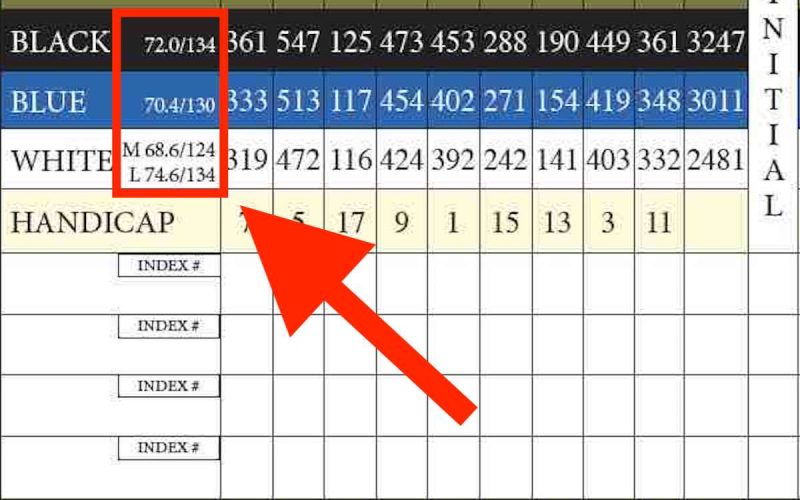Like all sports, understanding golf’s intricacies is helpful for improving your skills or enjoyment of the game. One of the most significant aspects of golf is the concept of a handicap. But what is a handicap in golf? How is it calculated? Why is it so essential? In the sections below, we will demystify the handicap system, discuss its importance, and share how it’s determined. Let’s jump in.
What is a Handicap in Golf ?

A golf handicap, also called an index, is a system developed by the United States Golf Association (USGA). It represents the number of additional strokes a player would need to complete a round of golf at a score of par. Par is the pre-determined number of strokes an average golfer should need to complete a course, which is commonly 72 strokes. A handicap is subtracted from the golfers final score to give a comparable net score to par. A lower handicap correlates to a better golfer. Therefore, a golfer’s handicap provides an estimation of how many strokes they may be over or under par when they play on any given course.
For instance, if your handicap is 15, it means that you are expected, on a good day, to shoot 15 strokes over par. A handicap of zero, also known as a scratch golfer, means the player can play to par and doesn’t need any additional strokes.
We should note that your golf handicap is not simply an average of all your round scores. The USGA uses a formula that takes into account not only your scores but also the difficulty of the courses you’ve played. We share this calculation further below. But, a golfer who consistently scores high on challenging courses could potentially have a lower handicap than a golfer who shoots lower scores on easier courses.
What is the Purpose of a Handicap?
A golf handicap provides value in a couple of ways. Both can enhance the enjoyment and competitiveness of the game.
Leveling the Playing Field
The primary purpose of a golf handicap is to level the playing field among golfers of differing abilities. This ways players with less skills are able to be competitive against more skilled players by providing a fair adjustment of scores. For example, suppose a golfer with a handicap of 16 competes against a scratch golfer (handicap of zero). In that case, the former will receive an extra 16 strokes. This way, both players have an equal chance of winning despite their different skill levels.
Measuring Your Improvement
Another significant benefit of having a golf handicap is that it allows you to monitor your progress over time. By consistently tracking your scores and updating your handicap, you can see whether your golf skills are improving or not. The handicap system is dynamic and adjusts based on your recent performances. If you have been playing well and your scores are lower than before, your handicap will decrease to reflect your improved skills. Conversely, if your performance declines, your handicap may increase. Therefore, your golf handicap serves as a real-time reflection of your current skill level.
How to Calculate a Golf Handicap
Calculating a golf handicap may seem complex at first glance, but it is a straightforward process once understood. The handicap is designed to reflect a golfer’s potential, not their average score, so it’s based on the best scores they’ve had recently. It measures a golfer’s consistency and skills relative to the course they’re playing on.
Factors Involved
The process of calculating a golf handicap involves taking into consideration your recent golf scores, the course ratings (difficulty level), and the slope rating (degree of difficulty for a bogey golfer compared to a scratch golfer) of the courses played. These are usually found on the course scorecard for each set of tees.
- Player’s Scores: This includes scores from recent rounds. Not every round is counted, but a select number of the best rounds are used.
- Course Rating: This is a numerical value given to each set of tees at every golf course to indicate the number of strokes a scratch golfer should take to complete the course. This rating signifies the difficulty of a golf course. It is based on factors like course length, obstacles, and other factors that impact difficulty.
- Slope Rating: This denotes the relative difficulty of a course for a bogey golfer compared to a scratch golfer. The average slope rating is 113.

Step-by-Step Guide to Calculating Your Golf Handicap
- Record your scores: At the end of each round of golf, be sure to record your score. It’s important to note that only rounds played on a course with a valid Course and Slope Rating can be used for handicap calculations.
- Choose your best rounds: From your recent rounds (the last 20 rounds), select the 8 rounds with the lowest score differentials.
- Calculate Score Differential: For each round, calculate the Score Differential using the formula: (Score – Course Rating) * 113 / Slope Rating.
- Calculate the average: Average the Score Differentials of these 8 rounds.
- Multiply by 0.96: Multiply this average by 0.96. The resulting figure, rounded to the nearest tenth, is your Handicap Index.
Remember, the golf handicap system reflects your potential ability, not your average performance. It’s a way to measure your progress and enjoy fair competition with other golfers.
Final Thoughts
In conclusion, the golf handicap serves a significant purpose in golf. It’s more than just a number; it indicates a player’s potential ability on the golf course. This unique system considers various factors, such as course and slope ratings, to offer a fair and standardized measurement for gauging a player’s skill level. Its fundamental purpose is to level the playing field, enabling golfers of differing abilities to compete against one another in a balanced and fair way.
The golf handicap isn’t just for fostering fair competition; it’s also a valuable tool for tracking improvement. By regularly calculating your handicap, you can accurately assess your progress over time, identify areas of improvement, and work to lower your scores. Allowing players of all skills to engage in healthy competition promotes the game’s spirit while encouraging continuous improvement. Ultimately, the golf handicap system lies at the heart of what makes golf both challenging and endlessly rewarding.



